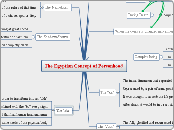The Egyptian Concept of Personhood
During Life
The body was called ''khet'' or ''iru'', meaning form or appearence
During Death
The corpse was known as ''khat''
When the corpse is changed into a mummy
It is called ''sah''
Complex being
could exist both before and after death in different manifestations known as Kheperu
The Physical body, the heart and the shadow are modes of existence
The name is used to embody a person's distinct identity
The Name(Ren)
Was regarded as a living part of each individual
Could often follow those of the rulers of that time
Could incorporate the name of a chosen god or diety
The Shadow(Shewt)
An entity imbued with power and capable of moving at great speed
A pharoe is often seen portrayed under the shade of a feather or palm fan
Represented as a small human figure painted completly black
The ''Ba''
It used to carry the deceased's body from the tomb, to join the ''ka'', in order to transform into an ''akh''
The physical body of the deceased could only survive after life by being combined with the ''ba'' every night
It was represented with a bird that had human head and arms
It was provided with the same needs of the physical body
The ''ka''
The initial dimension that seperated a living person from a dead one
Represented by a pair of arms pointing upwards
It was thought to absorb the life preserving force of the food being offered to it
After death, it would be in a rest state while the body is being prepared to be transformed into a mummy
The ''Akh''
The fully glorified and resurrected form of the deceased in the after life
It is considered enduring and unchanged for eternity due to the successful union of the ''ka'' and the ''ba''
